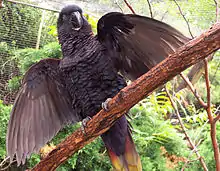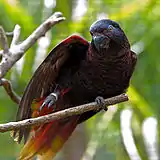Chalcopsitta
Chalcopsitta is a genus of parrot in the family Psittaculidae and the subfamily Loriinae. All three species are native to New Guinea and western offshore islands. The name Chalcopsitta is derived from the Greek khalkos meaning "bronze" and psitta meaning "parrot".[1]
| Chalcopsitta | |
|---|---|
 | |
| Black lory at Prague Zoo | |
| Scientific classification | |
| Kingdom: | Animalia |
| Phylum: | Chordata |
| Class: | Aves |
| Order: | Psittaciformes |
| Family: | Psittaculidae |
| Subfamily: | Loriinae |
| Genus: | Chalcopsitta Bonaparte, 1850 |
Description
The three species of the genus Chalcopsitta are about 31 – 32 cm (13 in) long. They have long tails, and prominent bare skin at the base of the lower mandible. Males and females have similar external appearance, and juveniles have duller plumage with more marked bare eye-rings.[2]
Taxonomy
The genus Chalcopsitta contains three species and several subspecies:[3]
Chalcopsitta Bonaparte 1850
- Chalcopsitta atra (Scopoli 1786) (black lory)
- Chalcopsitta atra atra (Scopoli 1786)
- Chalcopsitta atra bernsteini Rosenberg, HKB 1861
- Chalcopsitta atra insignis Oustalet 1878
- Chalcopsitta duivenbodei Dubois 1884 (brown lory)
- Chalcopsitta duivenbodei duivenbodei Dubois 1884
- Chalcopsitta duivenbodei syringanuchalis Neumann 1915
- Chalcopsitta scintillata (Temminck 1835) (yellowish-streaked lory)
- Chalcopsitta scintillata scintillata (Temminck 1835)
- Chalcopsitta scintillata chloroptera Salvadori 1876
- Chalcopsitta scintillata rubrifrons Gray, GR 1858
Species details
| Species of Chalcopsitta in taxonomic sequence | |||
|---|---|---|---|
| Common and binomial names[3] | Image | Description | Range |
| Black lory Chalcopsitta atra |
 |
32 cm (13 in) long. Mostly black with blue rump. Black bill. Red markings on face, thighs, and tail vary between the three subspecies.[2] | Misool Island and West Papua, New Guinea, Indonesia[4][5] |
| Brown lory Chalcopsitta duivenbodei |
-7.jpg.webp) |
31 cm (12 in) long. Mostly brown with a blue rump and yellow on face.[2] | Northern New Guinea[5][6] |
| Yellowish-streaked lory Chalcopsitta scintillata |
 |
31 cm (12 in) long. Mostly green with yellow streaking. Red on head varies between three subspecies.[2] | Aru Islands and Southern New Guinea from Triton Bay in Papua to Port Moresby in Papua New Guinea[5][7] |
References
- Jobling, James A. (1991). A Dictionary of Scientific Bird Names. Oxford: Oxford University Press. p. 48. ISBN 0-19-854634-3.
- Forshaw (2006). plate 7.
- "Zoological Nomenclature Resource: Psittaciformes (Version 9.022)". www.zoonomen.net. 28 March 2009.
- BirdLife International (2008). "Chalcopsitta atra". IUCN Red List of Threatened Species. 2008. Retrieved 14 April 2009.CS1 maint: ref=harv (link)
- Collar (1997) pages 341
- BirdLife International (2008). "Chalcopsitta duivenbodei". IUCN Red List of Threatened Species. 2008. Retrieved 14 April 2009.CS1 maint: ref=harv (link)
- BirdLife International (2008). "Chalcopsitta sintillata". IUCN Red List of Threatened Species. 2008. Retrieved 14 April 2009.CS1 maint: ref=harv (link)
Cited texts
- Collar N (1997) "Family Psittacidae (Parrots)" in Handbook of the Birds of the World Volume 4; Sandgrouse to Cuckoos (eds del Hoyo J, Elliott A, Sargatal J) Lynx Edicions:Barcelona. ISBN 84-87334-22-9
- Forshaw, Joseph M. (2006). Parrots of the World; an Identification Guide. Illustrated by Frank Knight. Princeton University Press. ISBN 0-691-09251-6.
External links
 Media related to Chalcopsitta at Wikimedia Commons
Media related to Chalcopsitta at Wikimedia Commons Data related to Chalcopsitta at Wikispecies
Data related to Chalcopsitta at Wikispecies
This article is issued from Wikipedia. The text is licensed under Creative Commons - Attribution - Sharealike. Additional terms may apply for the media files.